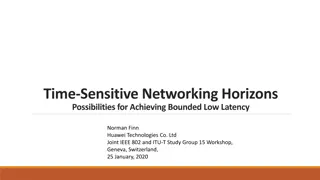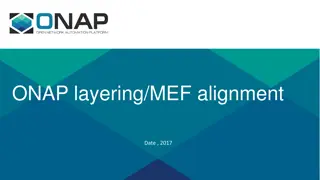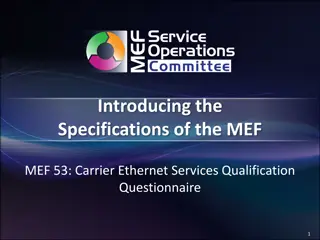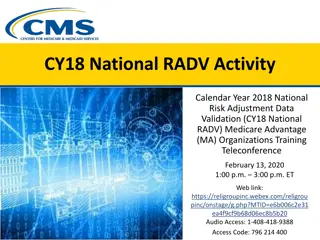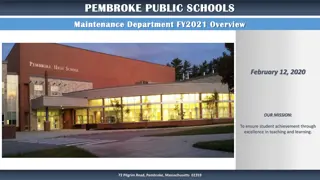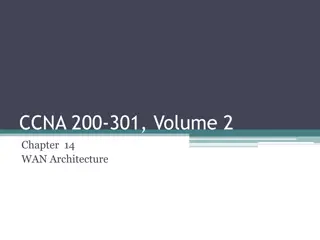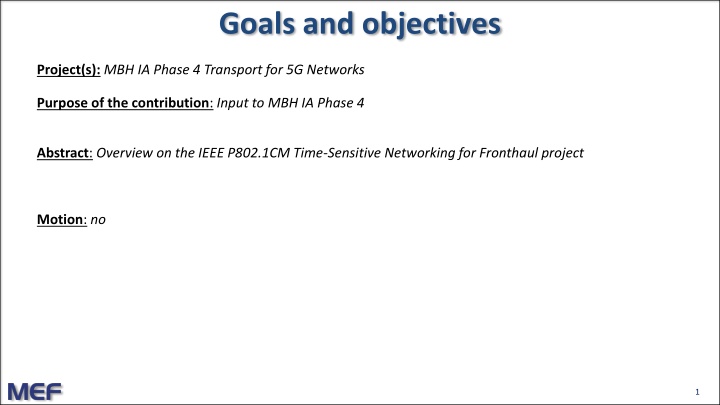
Time-Sensitive Networking for 5G Networks: Overview and Goals
Explore the integration of IEEE P802.1CM Time-Sensitive Networking in 5G networks, focusing on fronthaul projects and collaborative efforts. Dive into TSN components, standards, 5G overview, device-to-device communication, and critical control applications. Discover the essential functionalities and spectrum flexibility of 5G for diverse use cases, emphasizing the importance of Ethernet-based fronthaul in 5G transport networks.
Download Presentation

Please find below an Image/Link to download the presentation.
The content on the website is provided AS IS for your information and personal use only. It may not be sold, licensed, or shared on other websites without obtaining consent from the author. If you encounter any issues during the download, it is possible that the publisher has removed the file from their server.
You are allowed to download the files provided on this website for personal or commercial use, subject to the condition that they are used lawfully. All files are the property of their respective owners.
The content on the website is provided AS IS for your information and personal use only. It may not be sold, licensed, or shared on other websites without obtaining consent from the author.
E N D
Presentation Transcript
Goals and objectives Project(s): MBH IA Phase 4 Transport for 5G Networks Purpose of the contribution: Input to MBH IA Phase 4 Abstract: Overview on the IEEE P802.1CM Time-Sensitive Networking for Fronthaul project Motion: no 1
IEEE P802.1CM Time-Sensitive Networking for Fronthaul J nos Farkas Ericsson April 25, 2017 MEF 61035
Agenda Introduction IEEE 802.1 Time-Sensitive Networking (TSN) overview 5G overview, 5G fronthaul, Radio Base Station split Approach to Ethernet-based fronthaul IEEE 802.1CM TSN for Fronthaul goals and objectives Collaborative effort of CPRI Cooperation and IEEE 802.1 Top Down Approach Requirements Fronthaul Profiles (so far) Summary of IEEE P802.1CM Potential MEF 22 P802.1CM collaboration items 3
IEEE 802.1 Time-Sensitive Networking (TSN) Overview TSN Components Common Standards Time synchronization: Timing and Synchronization (802.1AS) includes a profile of IEEE 1588 Ultra reliability: Frame Replication and Elimination (P802.1CB) Path Control and Reservation (802.1Qca) Per-Stream Filtering and Policing (802.1Qci) Reliability for time sync (P802.1AS-Rev) Synchronization Reliability Latency Bounded low latency: Credit Based Shaper (802.1Qav) Frame preemption (802.3br & 802.1Qbu) Scheduled Traffic (802.1Qbv) Cyclic Queuing and Forwarding (802.1Qch) Asynchronous Traffic Shaping (P802.1Qcr) Resource Mgmt Dedicated resources & API Stream Reservation Protocol (802.1Qat) TSN configuration (P802.1Qcc) YANG (P802.1Qcp) Link-local Registration Protocol (P802.1CS) Zero congestion loss Guaranteed data transport with bounded low latency, low delay variation, and extremely low loss http://www.ieee802.org/1/pages/tsn.html API: Application Programming Interface; YANG: a data modeling language Note: selecting features is a task in the P802.1CM TSN for Fronthaul project 4
5G Overview Device-to-Device Communication 5G Radio Access 5G Use Cases Broadband everywhere Smart vehicles transport and infrastructure Media everywhere Critical control of remote devices Interaction human IoT and more 5G Core functionality Spectrum Flexibility Larger BW Higher Frequencies 10 GHz Service enablers and optimizations 3 GHz 30 GHz 100 GHz Flexible deployment of network functions Ultra-lean Design Inter-Site Cooperation Management Orchestration Network management Analytics Access-backhaul Integration (incl. self-backhauling) Multi-antenna technologies Multi-use case Utilize NFV and SDN Network programmability Common toolbox Fixed access Cloud Infrastructure Legacy RATs Network integrated compute and storage 5G Transport Backhaul SDN Network programmability Aggregation Optical enablers Fronthaul Ethernet-based fronthaul is integral part of 5G 5
5G Fronthaul Simplified Architecture backhaul Radio Base Station (RBS) Radio Equipment (RE) Radio Equipment Control (REC) backhaul baseband Radio Base Station (RBS) 6
Radio Base Station Split Current split (CPRI 7.0) Furthersplits are possible No split Possible splits PDCP: Packet Data Convergence Protocol RLC: Radio Link Controller PDCP RLC MAC PHY PDCP RLC MAC PHY Radio Layer 3 Layer 3 Layer 3 Layer 3 Layer 3 Layer 2 Layer 2 Layer 2 Layer 2 Layer 2 eCPRI Layer 1 Layer 1 Layer 1 Layer 1 Layer 1 Radio Radio Radio Radio Radio Radio Current focus of P802.1CM is the functional split specified by the Common Public Radio Interface (CPRI) 7.0 Next step in P802.1CM is eCPRI (http://www.cpri.info/press.html) Further functional splits can be addressed in 802.1CM amendment 7
Approach to Ethernet-based Fronthaul fronthaul interface Radio Domain RE REC MEF Services MEF UNI Packet Domain (Ethernet-based) IEEE 802.1/802.3 Ethernet network Ethernet networking specified by IEEE 802.1CM TSN for Fronthaul 8
IEEE 802.1CM TSN for Fronthaul Goals & Objectives RE1 Bridged network for Fronthaul REC1 RE2 RE3 REC2 Standard TSN Profiles for fronthaul Enable the transport of fronthaul streams in a bridged network A TSN Profile Specifies aspects of bridge operation Set of feature and option selections Configuration guideline 9
Collaborative effort of CPRI Cooperation and IEEE 802.1 CPRI Cooperation http://www.cpri.info/ Fronthaul experts Continuous development of CPRI specifications for 15 years eCPRI (http://www.cpri.info/press.html) IEEE 802.1 http://www.ieee802.org/1/ Ethernet networking experts Packet networking standards for decades Time-Sensitive Networking (TSN) Both organizations have proven that they deliver P802.1CM TSN for Fronthaul is a collaborative effort Joint sessions: face-to-face and virtual Common members Ethernet-based packet fronthaul is on its way 10
P802.1CM Project Takes Top Down Approach 1. Collect requirements CPRI Cooperation provides use cases and requirements 2. Collect the packet networking and synchronization features to address requirements Bridging features and characteristics Time-Sensitive Networking features Synchronization solutions and approaches ITU-T Q13/15 contributes (e.g., how to leverage the IEEE 1588 Telecom profile) 3. Specify solution details Profiles specify how to meet the fronthaul requirements in an Ethernet network 11
Requirements Contributed by CPRI Cooperation Class 1 RBS functional split is according to CPRI 7.0 CPRI information flows are separated from each other IQ data and the C&M data are independent data streams, NO CPRI Eth mapping as is IQ data requirements maximum end-to-end One-way Frame Delay = 100 s (no requirement on Frame Delay Variation) maximum Frame Loss Ratio = 10-7 C&M data requirement: maximum Frame Loss Ratio = 10-6 Class 2 eCPRI (to be added) Synchronization Synchronization is provided separately from IQ and C&M, e.g., GNSS, PTP 4 time synchronization requirement Categories for different 3GPP features 12
Fronthaul Profiles for Class 1 (so far) Profiles are engineered taking into account the worst-case Profile A Keep it as simple as possible Based on strict priority IQ data high priority traffic class C&M data lower priority traffic class Max frame size for all traffic: 2000 octets (IEEE 802.3) Profile B Leverage simple TSN features Based on strict priority and frame preemption (802.3br and 802.1Qbu) IQ data high priority traffic class; express traffic C&M data lower priority traffic class; preemptable traffic Frame size maximized for IQ data; arbitrary for other traffic 13
Ethernet-based Fronthaul with IEEE 802.1CM Radio Domain fronthaul interface CPRI, eCPRI, etc. fronthaul flows are separated, e.g., by priority, VID synchronization is separated from fronthaul data flows RE REC MEF Services MEF UNI edge ports perform std IEEE 802.1/802.3 Ethernet encapsulation Packet Domain IEEE 802.1CM IEEE 802.1CM Fronthaul Profiles meet the requirements of fronthaul flows Synchronization can be provided by packet network, e.g., Sync as a Service (SaaS) IEEE 802.1/802.3 Ethernet encapsulation 14
P802.1 CM Summary IEEE 802.1CM specifies TSN Profiles for Fronthaul It is a collaborative effort of CPRI Cooperation and IEEE 802.1 The project takes top down approach: requirements Requirements are provided by CPRI Cooperation Current focus: RBS split according to CPRI 7.0 and the different fronthaul information flows are supported separately Two Fronthaul Profiles (so far) Support for eCPRI is next step Work in progress; Welcome to contribute! http://www.ieee802.org/1/pages/802.1cm.html solution 15
Potential MBH IA P802.1CM Collaboration Items Sync as a Service (SaaS) SaaS provided by the Ethernet network is one of the options to provide synchronization for fronthaul if the requirements are met SaaS specified by MEF 22.2 and 22.2.1 is referred in IEEE 802.1CM Potential discussion items for MBH IA Phase 4 Transport for 5G 3 different CoS are needed for fronthaul: user (IQ) data + C&M + Sync Sync is already defined The requirements of user (IQ) data and C&M have to be met Any new CoS? 16

![❤[READ]❤ Deep Space Craft: An Overview of Interplanetary Flight (Springer Praxis](/thumb/21511/read-deep-space-craft-an-overview-of-interplanetary-flight-springer-praxis.jpg)
